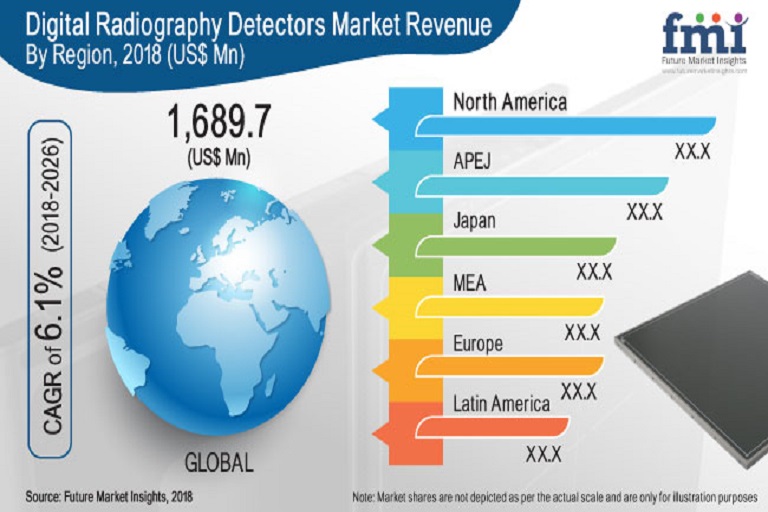Distinct Benefits over Contemporary Imaging Equipment to Put Digital Radiography Detectors Market on a Promising Growth Pedestal
The global demand for digital radiography detectors is expected to grow at a robust pace over the eight-year forecast period, 2018-2026. As projected in a recently released market intelligence, Future Market Insights expects the global digital radiography detectors market to reach a valuation of US$ 2,713.7 Mn by 2026, exhibiting a promising 6.1% CAGR during 2018-2026.
Increase in number of radiography tests performed globally each year coupled with introduction of new and advanced imaging equipment by key market players will remain predominant factors pushing the demand for digital radiography detectors – with significant adoption of direct flat panel detectors. Moreover, considering distinct benefits over computed radiography (CR), charged couple detectors (CCD), and analog detectors (film based), digital radiography detectors are expected to witness high traction in the coming years.
Read On to the More Advanced Regarding Digital Radiography Detectors Market: https://www.futuremarketinsights.com/reports/sample/rep-gb-7238
New products that can be used to upgrade the current analog and CR detector systems to digital radiography systems—especially catering to small hospitals and imaging centers, is likely to accelerate the growth of digital radiography detectors market in the next eight years.
North America and Europe are likely to remain the dominant regions in the digital radiography detectors markets, attributed to growing demand for X-ray Detectors and strong geographical presence of major manufacturers, respectively. Moreover, manufacturers of digital radiography detectors are increasingly focusing on launching products in emerging countries considering an unmet demand for digital radiography detectors and significant dependence on analog (film based) detectors.
The global market for digital radiography detectors is highly consolidated, with top players including Varex Imaging Corporation and Trixell holding close to 47% of the total market share. FMI expects key market players to focus on strategic acquisitions and collaboration and emphasis on cost effective product development, in addition to augmenting investments in product innovations and NPD.
A large number of players in the market are also investing in R&D and introduction of new products based on proprietary technologies, with focus on product differentiation. Moreover, shifting preference toward direct digital radiography (DDR) and a-Si detectors would present new market opportunities for emerging players working on innovative product offerings. Furthermore, imaging equipment manufacturers have an opportunity to improve their revenue stream by providing cloud storage services for medical imaging and information management, without scrapping of existing Picture Archiving and Communication (PACS).
Promising benefits of using indirect conversion technique of the digital radiography (DR) technology which involves use of amorphous silicon (a-Si) photodiodes and cesium iodide (CsI) scintillators for X-ray detection is projected to drive the adoption of digital radiography detectors. The benefits of Si X-ray detectors, mostly used in dental CBCT and orthopedic imaging includes lower patient radiation dose, reduced exam time, lower noise, and increased efficiency. More advanced applications in Mammography imaging and breast CT have pushed key players to expand their product offerings, with designs and technologies specific to aforementioned imaging.
Request to Browse Report Customization @ https://www.futuremarketinsights.com/customization-available/rep-gb-7238
However, high cost of C-arms compared to traditional X-Ray systems could inhibit the adoption of Fluoroscopy Imaging Systems, especially in low and middle income countries with lower rate of healthcare expenditure. Additionally, new technologies with improved benefits such as improved spatial image resolutions, better image quality owing to lower pixel imaging, and increased cost-benefit ratios are projected to restrict the growth of digital radiography detectors market.






























